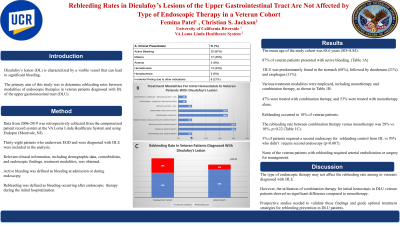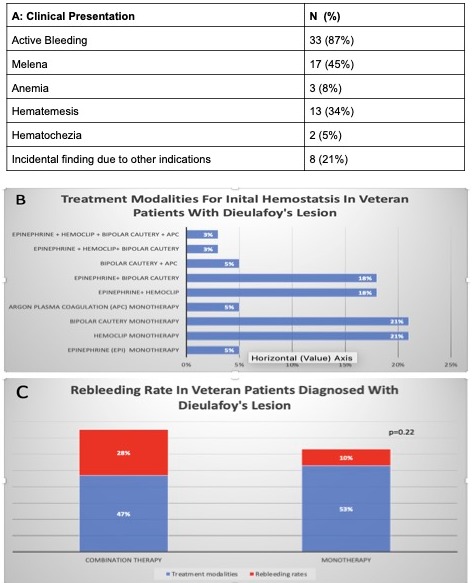Sunday Poster Session
Category: GI Bleeding
P0596 - Rebleeding Rates in Dieulafoy’s Lesions of the Upper Gastrointestinal Tract Are Not Affected by Type of Endoscopic Therapy in a Veteran Cohort
Sunday, October 22, 2023
3:30 PM - 7:00 PM PT
Location: Exhibit Hall

Has Audio
- FP
Femina Patel, MD
University of California Riverside
San Bernardino, CA
Presenting Author(s)
Femina Patel, MD1, Christian Jackson, MD2
1University of California Riverside, San Bernardino, CA; 2VA Loma Linda Healthcare System, Loma Linda, CA
Introduction: Dieulafoy’s lesion (DL) is characterized by a visible vessel that can lead to significant bleeding. The primary aim of this study was to determine rebleeding rates between modalities of endoscopic therapies in veteran patients diagnosed with DL of the upper gastrointestinal tract (DLU).
Methods: Data from 2006-2019 was retrospectively collected from the computerized patient record system at the VA Loma Linda Healthcare System and using Endopro (Montvale, NJ). Thirty-eight patients who underwent EGD and were diagnosed with DLU were included in the analysis. Relevant clinical information, including demographic data, comorbidities, and endoscopic findings, treatment modalities, was obtained. Active bleeding was defined as bleeding at admission or during endoscopy. Rebleeding was defined as bleeding occurring after initial treatment during the current hospitalization.
Results: A totThe mean age of the study cohort was 68.6 years (SD=8.84). 87% of veteran patients presented with active bleeding. Other presentations observed are listed in Table 1A. DLU was predominantly found in the stomach (68%), followed by duodenum (21%) and esophagus (11%). Various treatment modalities were employed, including monotherapy and combination therapy, as shown in Table 1B. 47% were treated with combination therapy, and 53% were treated with monotherapy alone. Rebleeding occurred in 18% of veteran patients. The rebleeding rate between combination therapy versus monotherapy was 28% vs. 10%, p=0.22 (Table 1C). Of all, 95% of patients didn't require a second endoscopy compared to 5% for rebleeding management (p=0.007).None of the veteran patients with rebleeding required arterial embolization or surgery for management.
Discussion: The type of endoscopic therapy may not affect the rebleeding rate among in veterans diagnosed with DLU. However, the utilization of combination therapy for initial hemostasis in DLU veteran patients showed no significant difference compared to monotherapy. Additionally, none of the veteran patients with rebleeding required arterial embolization or surgery for management. Prospective studies with a larger patient population will need to be performed to further validate these findings and guide optimal treatment strategies for rebleeding prevention in DLU patients.

Disclosures:
Femina Patel, MD1, Christian Jackson, MD2. P0596 - Rebleeding Rates in Dieulafoy’s Lesions of the Upper Gastrointestinal Tract Are Not Affected by Type of Endoscopic Therapy in a Veteran Cohort, ACG 2023 Annual Scientific Meeting Abstracts. Vancouver, BC, Canada: American College of Gastroenterology.
1University of California Riverside, San Bernardino, CA; 2VA Loma Linda Healthcare System, Loma Linda, CA
Introduction: Dieulafoy’s lesion (DL) is characterized by a visible vessel that can lead to significant bleeding. The primary aim of this study was to determine rebleeding rates between modalities of endoscopic therapies in veteran patients diagnosed with DL of the upper gastrointestinal tract (DLU).
Methods: Data from 2006-2019 was retrospectively collected from the computerized patient record system at the VA Loma Linda Healthcare System and using Endopro (Montvale, NJ). Thirty-eight patients who underwent EGD and were diagnosed with DLU were included in the analysis. Relevant clinical information, including demographic data, comorbidities, and endoscopic findings, treatment modalities, was obtained. Active bleeding was defined as bleeding at admission or during endoscopy. Rebleeding was defined as bleeding occurring after initial treatment during the current hospitalization.
Results: A totThe mean age of the study cohort was 68.6 years (SD=8.84). 87% of veteran patients presented with active bleeding. Other presentations observed are listed in Table 1A. DLU was predominantly found in the stomach (68%), followed by duodenum (21%) and esophagus (11%). Various treatment modalities were employed, including monotherapy and combination therapy, as shown in Table 1B. 47% were treated with combination therapy, and 53% were treated with monotherapy alone. Rebleeding occurred in 18% of veteran patients. The rebleeding rate between combination therapy versus monotherapy was 28% vs. 10%, p=0.22 (Table 1C). Of all, 95% of patients didn't require a second endoscopy compared to 5% for rebleeding management (p=0.007).None of the veteran patients with rebleeding required arterial embolization or surgery for management.
Discussion: The type of endoscopic therapy may not affect the rebleeding rate among in veterans diagnosed with DLU. However, the utilization of combination therapy for initial hemostasis in DLU veteran patients showed no significant difference compared to monotherapy. Additionally, none of the veteran patients with rebleeding required arterial embolization or surgery for management. Prospective studies with a larger patient population will need to be performed to further validate these findings and guide optimal treatment strategies for rebleeding prevention in DLU patients.

Figure: A: Clinical Presentation In Veteran Patients Diagnosed with Dieulafoy’s Lesion
B. Various Treatment Modalities Utilized In Veteran Patients Diagnosed with Dieulafoy’s Lesion
C. Rebleeding Rate Among The Patients Treated with Combination Therapy Vs Monotherapy.
B. Various Treatment Modalities Utilized In Veteran Patients Diagnosed with Dieulafoy’s Lesion
C. Rebleeding Rate Among The Patients Treated with Combination Therapy Vs Monotherapy.
Disclosures:
Femina Patel indicated no relevant financial relationships.
Christian Jackson indicated no relevant financial relationships.
Femina Patel, MD1, Christian Jackson, MD2. P0596 - Rebleeding Rates in Dieulafoy’s Lesions of the Upper Gastrointestinal Tract Are Not Affected by Type of Endoscopic Therapy in a Veteran Cohort, ACG 2023 Annual Scientific Meeting Abstracts. Vancouver, BC, Canada: American College of Gastroenterology.
